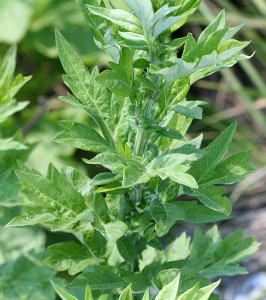 Mugwort, the bane of many gardeners, was used for centuries as both a medicinal and culinary herb throughout its native habitat of Eurasia, North Africa and North American. It was known by many names, such as felon herb, chrysanthemum weed, wild wormwood, old Uncle Henry, sailor’s tobacco, naughty man, old man or St. John’s plant. Common mugwort, Artemisia vulgaris, native to Europe and North America is best known here in the US.
Mugwort, the bane of many gardeners, was used for centuries as both a medicinal and culinary herb throughout its native habitat of Eurasia, North Africa and North American. It was known by many names, such as felon herb, chrysanthemum weed, wild wormwood, old Uncle Henry, sailor’s tobacco, naughty man, old man or St. John’s plant. Common mugwort, Artemisia vulgaris, native to Europe and North America is best known here in the US.
Mugwort has many uses in both traditional Chinese medicine and in Ayurvedic medicine. In Europe it was believed to prevent fatigue so travelers lined their shoes with the leaves. It was an ingredient in the Medieval European Nine Herbs Charm which was used to treat poisoning.
Mugwort was also believed to have magical properties. Native Americans used it because they believed that it kept ghosts away. John the Baptist supposedly wore a girdle made of mugwort as protection in the wilderness. In Northern Europe it was believed that if you gathered mugwort on St. John’s Eve it gave protection against diseases and misfortunes.
Many cultures have used mugwort in teas and traditional foods. In Europe it was used to flavor beer before the introduction of hops. Only dried plants were used because it was believed that the fresh leaves did not have the same flavor properties.
Mugwort contains small amounts of thujone which is a spasmodic. In small amounts, it isn’t harmful but if eaten in large quantities, it is toxic. Pregnant women should never consume mugwort because of the danger of early labor and miscarriage.
Common mugwort is a herbaceous perennial hardy in zones 3 – 9. It grows to a height of 3’ to 6’. It prefers full sun, but will tolerate some shade. It prefers well-drained soil and is drought tolerant. Thanks to its hardiness and drought tolerance, mugwort is considered an invasive weed in many parts of the US, often found along roadsides, in ditches and growing on unused lands.
Bloomtime is July to September. The flowers are small, yellow and arranged in panicles. Several species of moths and butterflies dine on mugwort leaves and flowers. Deadheading is a good idea to prevent the spread of seed. Better yet, cut off the flowers before they open if you have are a hayfever sufferer. Mugwort pollen is a major source of hay fever in North America, Europe and parts of Asia.
Mugwort is easy to grow from seed. You can direct sow your seed in the fall for germination in the spring or, indoors, cold stratify it for a couple of weeks in your refrigerator. Seed should be surface sown. Do not cover it. It needs light to germinate.
Mugwort can also be propagated by division in the spring.
Leaves can be harvested for drying starting in August. The roots should be harvested in the fall. The small rootlets must be removed prior to drying the roots to prevent mold from growing on the root.


13 Comments on “Mugwort”
I have been taking two big spoons if ground mugwort in boiling water but haven’t noticed a difference the vividness of my dreams
I do not recommend any herbs for altering mental states. From what little I know about mugwort and dreaming, you are not making your tea correctly or using enough mugwort. You need to do more research.
Great information!
I notice you said mugwort is a spasmodic but I’ve heard from a few folx that a mugwort salve or oil is relieving nighttime leg cramps for them. Thoughts?
I am not an herbalist. When I write about medicinal uses for herbs, I am just reporting the most common uses.
There was a lot of Mogwai growing on a plot of land so we cut some. I see that you say it should be harvested in the fall and the roots in the fall but the person was going to cut the mugwort back and throw it away. What should we do with it is it no good?
You can dry what you cut now for use later. The roots are tough and will grow foliage again. You want to hold off until fall to harvest the roots because they will be larger in the fall because they will have been growing all summer.
because of its invasive properties could it be grown inside or in pots? I am planning on adding it to my sacred garden but I dont want it to take over everything else
You might be able to grow it in a very large pot. It’s a large plant. Your other alternative is to plant it like gardeners plant bamboo (also very, very invasive). Surround it with a metal barrier that goes down 2 – 3 feet deep to prevent the roots from spreading.
Would you think it may grow as an annual in zone 10? Garden planting for us begins in August and pretty much done by mid May. We essentially have 2 full growing seasons back to back.
I think your summers are too hot for it. It would not survive the high temperatures.
Elise, I grow mine in containers. One plant per, 1/2 wine barrel type. It’s the plastic fake wine barrel 😉 Home Depot for $19. Worked fine.
Pingback: How to Grow Mugwort: A Comprehensive Guide - House and Home Online